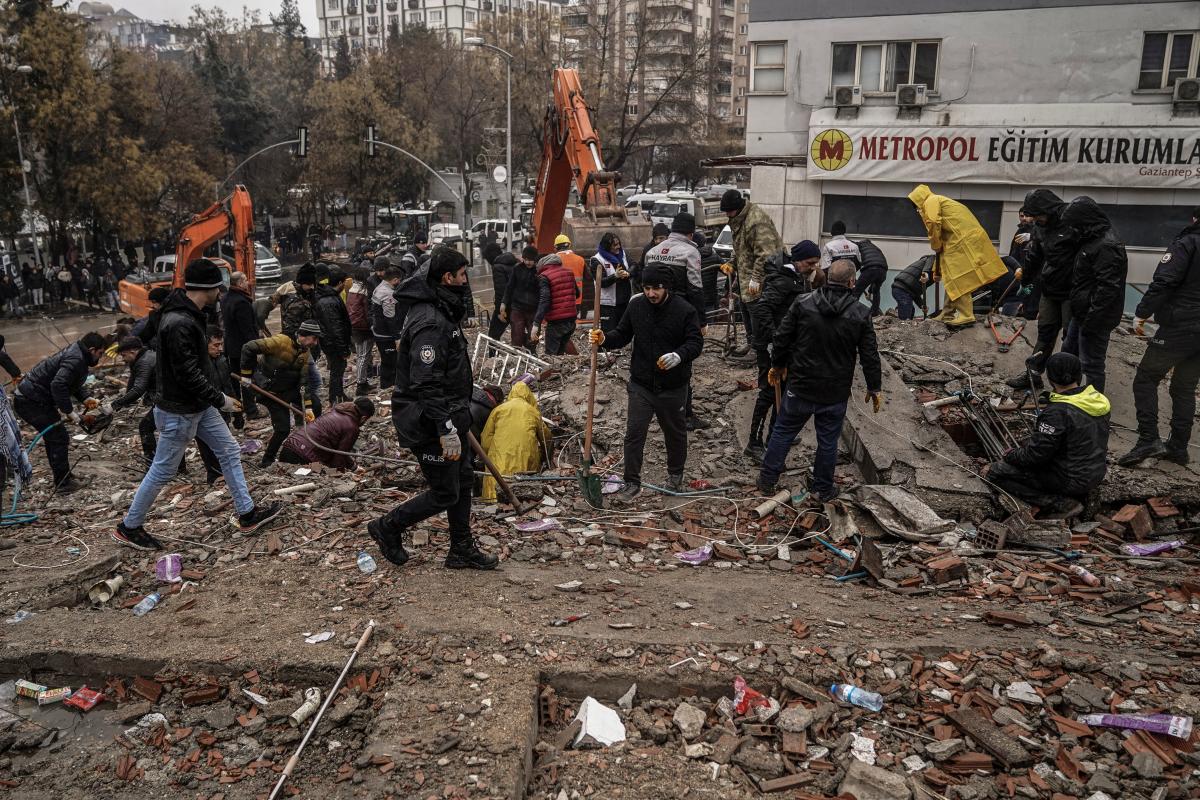“Fatal Earthquakes in Turkey: Uncovering the Reasons Behind the Tremors and Examining the Possibility of a Similar Event Occurring in the US”
Rescue workers are continuing recovery efforts in Turkey and Syria after a devastating series of earthquakes that began on February 6 near the two countries’ borders.
Authorities say the death toll has already passed 7,000 and is likely to rise further as an estimated 6,000 buildings have collapsed.
“We are facing one of the greatest disasters not only in the history of the Turkish Republic but also in the world,” Turkish President Recep Tayyip Erdogan said on Tuesday.
Because so many geological plates come together in this area, Turkey and Syria often experience devastating earthquakes compared to more geologically stable areas.
Here’s what you should know:
What caused the earthquakes in Turkey, Syria?
-
The Anatolian Fault System: The border between Turkey and Syria lies near the Anatolian fault system, where several geological plates interact: the African, the Anatolian (where Turkey sits), the Arabian and the Eurasian.
-
Plates move in different directions, different speeds: Turkey sits on the small Anatolian tectonic plate, which itself lies between several other plates that are moving in different directions and putting pressure on the fault lines.
-
Similar to the San Andreas Fault in California: This fault borders the Pacific and North American plates and is the source of “The Big One”, a legendary hypothetical earthquake that could devastate Los Angeles. Quakes in these areas are typically caused by horizontal faults known as strike faults.
-
How to visualize: It’s like squeezing a watermelon seed between your fingers — it stays in place until the pressure builds and the seed eventually pops out, said Susan Hough, a California-based US Geological Survey seismologist.
How long did the earthquake in Turkey, Syria last?
The 7.8-magnitude quake struck at 4:17 a.m. local time on February 6 in southern Turkey’s Kahramanmaras province, about 20 miles from the city of Gaziantep, according to the USGS. The USGS calculated the duration of the first tremor to be 60-75 seconds.
Numerous aftershocks followed, authorities said, and witnesses reported feeling the ground shaking for about two minutes. Hours later, a magnitude 7.5 quake struck more than 60 miles away. Several smaller tremors followed in the same area.
What other major earthquakes have happened in this region?
-
2020: Turkey was hit by a magnitude 6.7 earthquake in January, causing extensive damage.
-
1999: A series of earthquakes rocks north-west Turkey. A 7.4 magnitude quake rocked Istanbul, killing about 17,000 people.
-
1939: A 7.8 magnitude earthquake struck the Erzincan area, and in some areas the ground along the North Anatolian fault line slid more than 12 feet horizontally. According to the authorities, more than 30,000 people died in this earthquake.
Because Turkey is prone to earthquakes, many newly constructed buildings are designed to withstand significant shaking, usually by isolating them from the ground below with the equivalent of giant shock absorbers. In 2009, Turkey celebrated the completion of what was then the world’s largest earthquake-insulated building: the International Terminal at Istanbul’s Sabiha Gökçen Airport, perched atop 300 isolation pillars.
Could something like this happen in the United States?
Experts generally agree that the greatest earthquake risk for the United States is in California, where the Pacific and North American plates meet. The region generally has a higher risk of earthquakes than Turkey and Syria, but some of this is mitigated by strict building codes.
Apple’s $5 billion ring-shaped headquarters in nearby Cupertino, for example, stands on 700 “base isolators” that help protect it from earth movement below. California’s cities and communities have attempted to account for earthquake hazards since the 1906 San Francisco quake and the 1933 Long Beach quake.
“Building collapse is not as much of a threat in California as it is in Turkey. For many people here, falling things are a greater danger. That doesn’t mean some buildings won’t collapse,” said David Oglesby, a geophysicist professor at the University of California Riverside. in an email statement. “Most of our buildings, especially certain critical ones, are designed to withstand significant shaking.”
There is also a risk of earthquakes on the east coast, but building codes are often not as strict. New York City did not begin requiring earthquake considerations for new construction until 1995.
Large earthquakes can occur across the country. According to the USGS, the August 23, 2011 magnitude 5.8 quake in Mineral, Virginia was the most widespread earthquake in US history. That’s because East Coast tectonics allowed the quake to spread further than it could have in California and because it happened on the densely populated East Coast. This quake damaged the National Monument about 90 miles from the epicenter.
“If this quake had been closer to Washington DC, it could have been a real shock to the country,” Hough said.
What was the largest earthquake ever recorded?
Using modern measurement techniques, the largest earthquake ever recorded occurred on May 22, 1960 in Bio-Bio, Chile. The earthquake, known as the Valdivia earthquake, had a magnitude of 9.5, according to the USGS.
Featuring: Wyatte Grantham-Philips, John Bacon and Jorge L. Ortiz, USA TODAY; The Associated Press.
This article originally appeared on USA TODAY: Turkey Questions, Syria Earthquake Answered: Why There? US risk.
Don’t miss interesting posts on Famousbio










